Gotham's Denver Location Opens
Gotham Greens continues its nationwide expansion process with the announcement Wednesday that its Denver location is online. It’s the eighth location for the Brooklyn, New York, based company, and with the new 30,000 sq. ft. brings the total under glass to 500,000 sq. ft. of hydroponic leafy greens production. The greenhouse will ship to Whole Foods Market, Choice Markets, Alfalfa’s and other grocery outlets across seven states. It will also service restaurants and foodservice customers as they start to reopen.
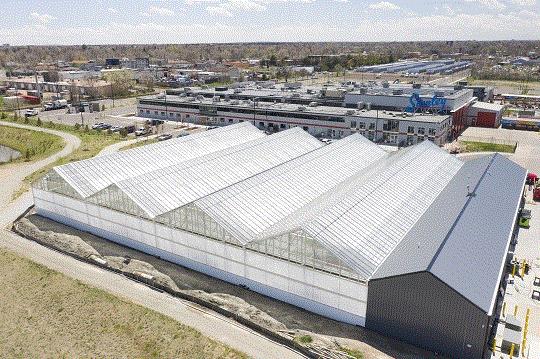
Along with introducing two new lettuce varieties, Crispy Green Leaf and Rocky Mountain Crunch, the company also unveiled a line of fresh salad dressings to be sold at Whole Foods Markets nationwide. Those dressings are Green Goddess, Vegan Goddess, Basil Caesar and Lemon Basil Vinaigrette.
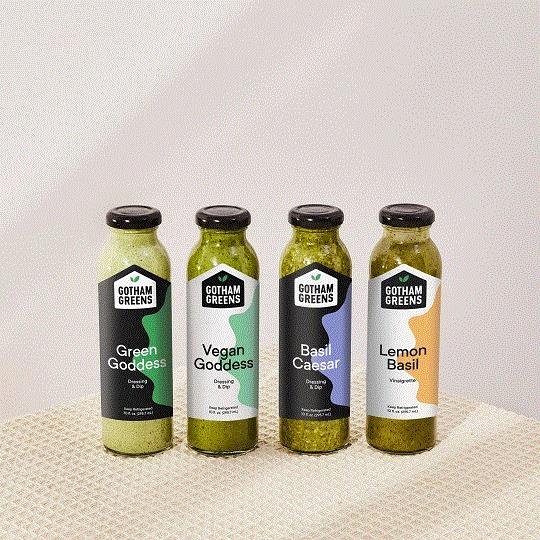
“Although we never envisioned our Denver greenhouse opening and national salad dressing rollout happening during a global pandemic, we’re proud to be providing people across the country with healthy, fresh food options they can get excited about,” says co-founder and CEO Viraj Puri. “With the rise of cooking at home, we’re seeing consumers get creative and enjoy our dressings in a variety of different ways—as a savory dip, tangy marinate or freshly tossed with salad greens.”
In case you’re keeping a running tally, the Denver location is in addition to two greenhouses in the Pullman neighborhood of Chicago, Greenpoint and Gowanus in Brooklyn, Jamaica in Queens, Providence, Rhode Island, and Baltimore, Maryland.

Worker Safety in a Pandemic
By now it’s likely you’ve heard about the COVID-19 outbreak at Green Empire Farms in Oneida, New York. If you haven’t, a quick recap is more than 150 workers at the massive strawberry, tomato and cucumber greenhouse have been diagnosed with the illness, according to the latest reports from local media. Two county health departments are investigating the outbreak, none of the workers have died as a result of the illness and 97% have recovered, according to officials at the Madison County Health Department (MCHD).
The MCHD conducted an investigation of the greenhouse and found “that Green Empire Farms does indeed have many protocols in place to limit the possible spread of COVID-19,” according to a May 9 statement from the health department, including taking employee temperatures, hand sanitizer and boot sanitation stations, spaced-out work stations, limits to the number of people on breaks, and limits to how many people can sit at a table at one time. “The MCHD is satisfied with the conditions at the greenhouse.”
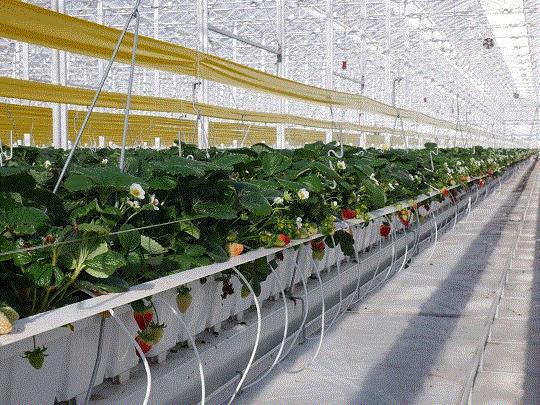
A photo of part of the strawberry range at Green Empire Farms in Oneida, New York, from a December 2019 visit.
However, the health department had found guestworkers were being housed at three local motels while on-site housing facilities were still being constructed (the pandemic shut down work on the facilities). Two are located in Madison County and one in Oneida County, according to local reports.
An Oneida television station reported last week MCHD officials told the grower and the company it contracted with to employ the guestworkers to complete the housing within 60 days and move workers out of the motels. On Wednesday, I reached out to Mastronardi Produce, which owns Green Empire Farms (you can read our February cover story about the operation HERE), and they haven't responded to my request for an interview or a statement.
What are the takeaways from this? Housing and transportation are probably two of the biggest challenges safety-wise facing growers. I reached out to Craig Regelbrugge at AmericanHort to ask about resources related to updated government recommendations in light of COVID-19, particularly related to housing. I was having trouble finding it on my own and Craig directed me to two rounds of updated FAQs put out by the U.S. Department of Labor Employment and Training Administration’s Office of Foreign Labor Certification. The latest FAQs from April 9, FOUND HERE, does help clarify some details regarding housing.
Craig also provided a link to guidance from AmericanHort related to some of these topics, which you can FIND HERE. However, I will repeat the caveat from the FAQs that the situation remains fluid and if you're unsure about how to move forward, please reach out to your experts to make final decisions.
Do you have questions related to keeping your employees safe? Email me and I’ll see if I can find an answer.

COVID-19 Relief Funds
First of all, I have to say I’m overwhelmed with the amount of information out there about potential funding for various sectors of agriculture and to whom it all applies. It’s really difficult to figure out who gets what and what needs to be paid back. I don’t find the information provided by the USDA to be very clear, either, in terms of who's eligible for this, so if someone has more insight, please drop me a line and enlighten me.
As far as I can tell, there’s relief for greenhouse, vertical farm and indoor growers through a couple of options. Here’s what’s out there.
Paycheck Protection Program (PPP) Act
This money is still in play and can be used by the ag sector. According to Wednesday’s AmericanHort webinar on PPP, about $145 billion is left to distribute from the program. This is according to the USDA website: “Agricultural producers, farmers and ranchers with 500 or fewer employees whose principal place of residence is in the United States are eligible.”
Also, initially guest workers would not count toward eligibility or calculation (my emphasis) of the PPP loan amount. However, there have been some modifications to this, according to speakers on the AmericanHort webinar. CLICK HERE for the USDA’s details on PPP eligibility (scroll down to the PPP section). You may receive a PPP loan as well as other relief offered by USDA. CLICK HERE for all the details from the Small Business Association and the interim final rulings.
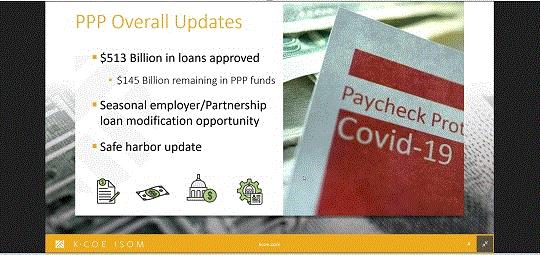
Coronavirus Food Assistance Program (CFAP)
Part of the $16 billion of direct payments to farmers and ranchers finalized yesterday by USDA Secretary Sonny Perdue also includes $2.1 billion for specialty crops, including strawberries and tomatoes, among many others. Producers can begin applying for this money Tuesday, May 26.
I emailed USDA to ask for clarification about whether this applies to indoor, vertical farm and greenhouse growers. Here’s the response I received from a USDA spokesperson:
The Coronavirus Food Assistance Program, or CFAP, is available to an individual or legal entity who shares in the risk of producing a crop or livestock and who either: A) is entitled to a share in the crop or livestock available for marketing; or B) would have shared had the crop or livestock been marketed.
Eligible commodities must have either: A) suffered a five percent-or-greater price decline; or B) experienced market supply chain disruptions due to COVID-19 and face additional significant marketing costs. These include:
Specialty crops: almonds, apples, artichokes, asparagus, avocados, beans, blueberries, broccoli, cabbage, cantaloupe, carrots, cauliflower, celery, sweet corn, cucumbers, eggplant, garlic, grapefruit, kiwifruit, lemons, iceberg lettuce, romaine lettuce, mushrooms, dry onions, green onions, oranges, papayas, peaches, pears, pecans, bell-type peppers, other peppers, potatoes, raspberries, rhubarb, spinach, squash, strawberries, sweet potatoes, tangerines, taro, tomatoes, walnuts, and watermelons.
The commodities currently included in the program are those for which USDA data was available to determine that a five percent-or-greater price decline occurred from mid-January 2020 to mid-April 2020. USDA is requesting data from the public on agricultural commodities not already included in CFAP, which may have been negatively impacted by the COVID-19 pandemic and for which sufficient information is not currently available to USDA. More information on submission requirements can be found in the Notice of Funding Availability (NOFA) on www.farmers.gov/cfap.
United Fresh Produce Association released a reaction from President and CEO Tom Stenzel: “We applaud the announcement of a direct payment program for fruit and vegetable growers. That being said, we understand the resource and policy constraints that have been placed on USDA and the Administration and will work closely with Congress on implementing a stronger and more effective program in the next round of discussion with Capitol Hill. It is essential that USDA and Congress focus on programs that target resources for growers, grower-shippers, and others in the produce distribution supply chain that had direct job losses and immediate financial impact from government-mandated closures.”
You can read more responses to the direct payment plan HERE.

Weeks' Worth of Webinars
We’ve got a multitude of education coming your way and it starts next week. Here’s a rundown of our webinar lineup and you can CLICK HERE to register for any and/or all of them (they’re all free). All are hosted by Bossman Beytes.
Strategies for Automating Your Fertigation System, Thursday, May 28 at 1:00 p.m. Eastern/Noon Central
Hear a panel of industry experts tackle ways to automate your fertigation system for fine-tuned irrigation and nutrient delivery in any production environment, including greenhouse, vertical farm and indoor growing. You’ll hear the panel cover the following topics:
-
Importance of automation in irrigation and nutrient-delivery systems
-
Flexible vs. stringent environmental controls when designing irrigation/nutrient delivery strategies
-
Control system integration to third-party devices
-
Supervision and remote control of fertigation delivery programs
-
The importance of data logging
-
Intelligent automation (AI)
-
The future of automated irrigation and nutrient delivery
The panel of experts includes:
Al Zylstra, Segment Manager for DRAMMwater
Jeff Neff, Senior Application Technician for Argus Control Systems
Eric Culberson, VP of Horticulture for Columbia Care
Chad M Salute, Director of Cultivation for Kush Alley
John Chandler, President for Cultivation Excellence
Special thanks to the sponsor, Argus Controls, for making this one happen!
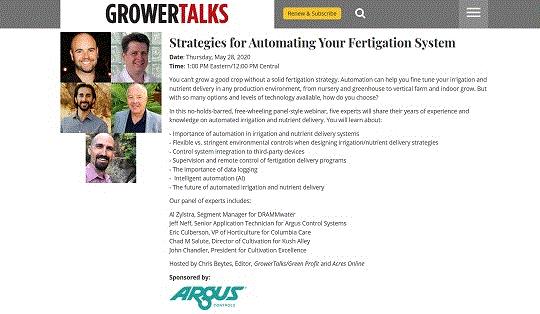
Fiber Pots: Can You Really Grow and Sell in Them?, Tuesday, June 9 at 1:00 p.m. Eastern/Noon Central
Customers often ask for alternatives to plastic and The HC Companies has come up with the EcoGrow Organic Growing Container, a fiber pot made from recycled, sustainable materials.
HC’s Bryce Anderson, who's spent more than a decade working on fiber pots, will detail what makes these containers special and back it up with details of trials done by growers in the real world. He’ll highlight growing environments, irrigation needs, performance and degradation, as well as retail sales, so webinar attendees can decide if fiber pots are right for their operation. And (alert: bonus ahead), attendees will have the opportunity to request a free sample kit of EcoGrow products as the end of the webinar.
Best IPM Practices for Piercing & Sucking Insects, Tuesday, June 16 at 1:00 p.m. Eastern/Noon Central
This webinar features Jen Browning and Peggy Clanton of BASF, and Jorge Bernal of Costa Farms talking about the best way to integrate biologicals and conventional tools to make both work when battling piercing and sucking insects. The discussion includes management of aphids, whiteflies, mealybug and scale insects on ornamentals, being in close contact with your target pests, seasonality and timing, and best approaches to IPM.

MSU Online Courses
Michigan State University Extension has new Online College of Knowledge greenhouse courses starting June 1, including a brand new course called Abiotic Disorders of Greenhouse Crops. These are all non-credit courses that are pre-recorded for those who want to learn more about areas of greenhouse crop production or pest management. All courses except the new one are available in English and Spanish. Registrants have three months to complete the courses: June 1 to August 31, and they'll take a pre-test and a final exam to gauge their learning on the topics.
Registration for all courses ends June 13, so don’t delay in signing up. Each course is $129 and there are three scholarships per course available for those with financial need. CLICK HERE for all the details. Here’s a quick rundown:
Abiotic Disorders of Greenhouse Crops: This is intended for greenhouse and ornamental plant growers who are interested in learning what factors induce or contribute to the onset of abiotic disorders of greenhouse crops. Read the full description HERE.
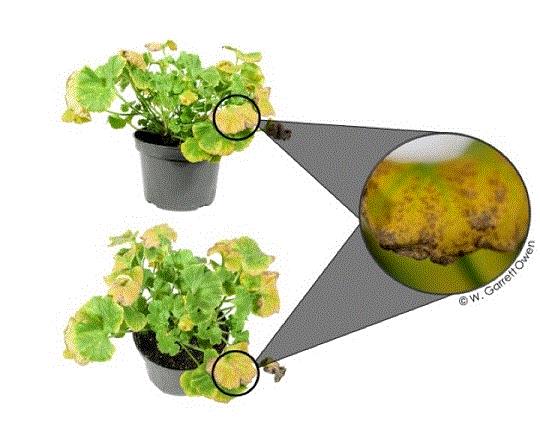
Biological Control for Greenhouse Growers: MSU partnered with Raymond Cloyd from Kansas State University Extension to offer this online course on biological control pest management intended for greenhouse growers and others interested in learning about the challenges and opportunities associated with a biological control pest management program.
Floriculture Root Zone Management: For beginner-level floriculture growers and covers the fundamental concepts of irrigation water, media and their effects on plant nutrition.
Greenhouse and Horticultural Lighting: For greenhouse and ornamental plant growers and others interested in learning about the fundamental concepts of how plants respond to light quality, quantity and duration. It provides introductory to moderately challenging content based on experiments performed at MSU and covers photoperiod; photoperiodic lighting; light quality, quantity and duration; and factors that should be considered when replacing or installing new lamps.




As always, feel free to email me at jpolanz@ballpublishing.com with comments, questions, news and views.
Until next time, stay safe and be healthy,

Jennifer Polanz
Editor-at-Large
Inside Grower
This email received by 24,592 loyal readers!
Interested in advertising in Inside Grower? Contact Paul Black or Kim Brown and they'll show you how easy, effective and affordable it is.